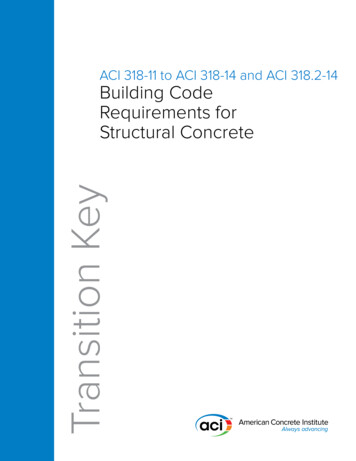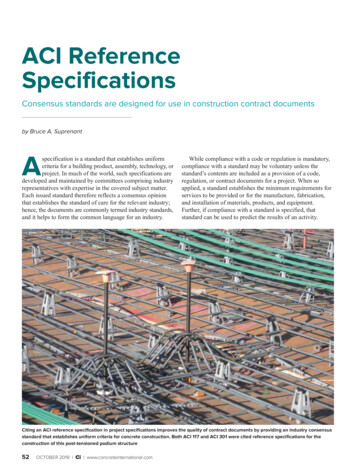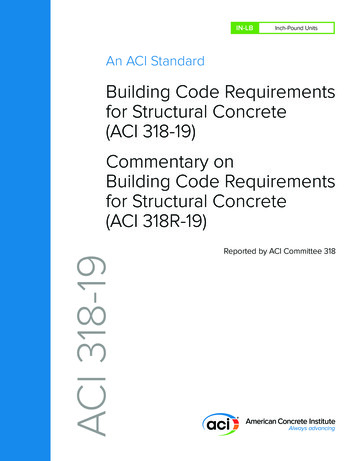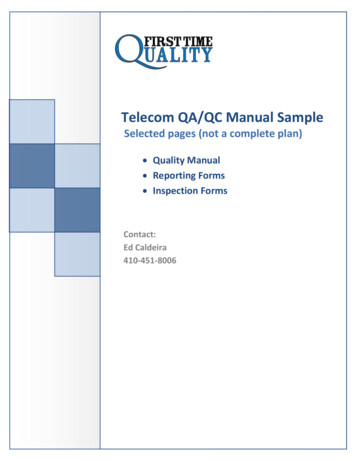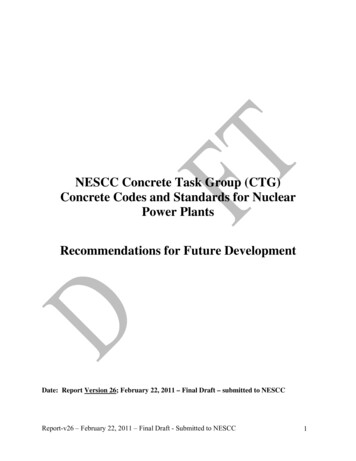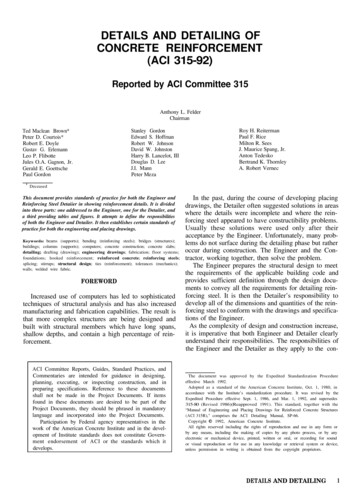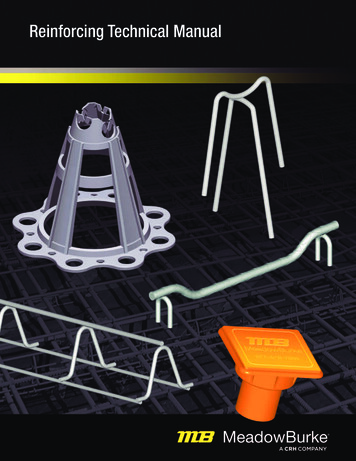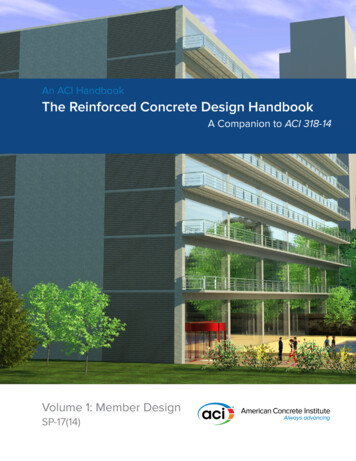
Transcription
An ACI HandbookThe Reinforced Concrete Design HandbookA Companion to ACI 318-14Volume 1: Member DesignSP-17(14)
ACI SP-17(14)THE REINFORCED CONCRETE DESIGN HANDBOOKA Companion to ACI 318-14VOLUME 1VOLUME 2BUILDING EXAMPLERETAINING WALLSSTRUCTURAL SYSTEMSSERVICEABILITYSTRUCTURAL ANALYSISSTRUT-AND-TIE MODELDURABILITYANCHORING TO CONCRETEONE-WAY SLABSTWO-WAY SLABSBEAMSDIAPHRAGMSCOLUMNSSTRUCTURAL REINFORCED CONCRETE WALLSFOUNDATIONS
ACI SP-17(14)Volume 1THE REINFORCED CONCRETEDESIGN HANDBOOKA Companion to ACI 318-14Editors:Andrew TaylorTrey Hamilton IIIAntonio Nanni
First PrintingSeptember 2015ISBN: 978-1-942727-37-8THE REINFORCED CONCRETE DESIGN HANDBOOKVolume 1 Ninth EditionCopyright by the American Concrete Institute, Farmington Hills, MI. All rights reserved. This material may not bereproduced or copied, in whole or part, in any printed, mechanical, electronic, film, or other distribution and storagemedia, without the written consent of ACI.The technical committees responsible for ACI committee reports and standards strive to avoid ambiguities,omissions, and errors in these documents. In spite of these efforts, the users of ACI documents occasionally findinformation or requirements that may be subject to more than one interpretation or may be incomplete or incorrect.Users who have suggestions for the improvement of ACI documents are requested to contact ACI via the erratawebsite at px. Proper use of this document includes periodicallychecking for errata for the most up-to-date revisions.ACI committee documents are intended for the use of individuals who are competent to evaluate the significance andlimitations of its content and recommendations and who will accept responsibility for the application of the materialit contains. Individuals who use this publication in any way assume all risk and accept total responsibility for theapplication and use of this information.All information in this publication is provided “as is” without warranty of any kind, either express or implied,including but not limited to, the implied warranties of merchantability, fitness for a particular purpose or noninfringement.ACI and its members disclaim liability for damages of any kind, including any special, indirect, incidental, orconsequential damages, including without limitation, lost revenues or lost profits, which may result from the use ofthis publication.It is the responsibility of the user of this document to establish health and safety practices appropriate to the specificcircumstances involved with its use. ACI does not make any representations with regard to health and safety issuesand the use of this document. The user must determine the applicability of all regulatory limitations before applyingthe document and must comply with all applicable laws and regulations, including but not limited to, United StatesOccupational Safety and Health Administration (OSHA) health and safety standards.Participation by governmental representatives in the work of the American Concrete Institute and in thedevelopment of Institute standards does not constitute governmental endorsement of ACI or the standards that itdevelops.Order information: ACI documents are available in print, by download, on CD-ROM, through electronic subscription,or reprint and may be obtained by contacting ACI. Most ACI standards and committee reports are gathered togetherin the annually revised ACI Manual of Concrete Practice (MCP).American Concrete Institute38800 Country Club DriveFarmington Hills, MI 48331 USA 1.248.848.3700Managing Editor: Khaled NahlawiStaff Engineers: Daniel W. Falconer, Matthew R. Senecal, Gregory M. Zeisler, and Jerzy Z. ZemajtisTechnical Editors: Shannon B. Banchero, Emily H. Bush, and Cherrie L. FergussonManager, Publishing Services: Barry BerginLead Production Editor: Carl BischofProduction Editors: Kelli Slayden, Kaitlyn Hinman, Tiesha ElamGraphic Designers: Ryan Jay, Aimee KahaianManufacturing: Marie Fullerwww.concrete.org
DEDICATIONThis edition of The Reinforced Concrete Design Handbook, SP-17(14), is dedicated to thememory of Daniel W. Falconer and his many contributions to the concrete industry. He wasManaging Director of Engineering for the American Concrete Institute from 1998 until hisdeath in July 2015.Dan was instrumental in the reorganization of Building Code Requirements for Structural Concrete (ACI 318-14) and Commentary (ACI 318R-14) as he served as ACI staffliaison to ACI Committee 318, Structural Concrete Building Code; and ACI Subcommittee318-SC, Steering Committee. His vision was to simplify the use of the Code for practitioners and to illustrate the benefits of the reorganization with this major revision ofSP-17. His oversight and review comments were instrumental in the development of thisHandbook.An ACI member since 1982, Dan served on ACI Committees 344, Circular PrestressedConcrete Structures, and 373, Circular Concrete Structures Prestressed with Circumferential Tendons. He was also a member of the American Society of Civil Engineers. Prior tojoining ACI, Dan held several engineering and marketing positions with VSL Corp. Beforethat, he was Project Engineer for Skidmore, Owings, and Merrill in Washington, DC. Hereceived his BS in civil engineering from the University of Buffalo, Buffalo, NY and hisMS in civil and structural engineering from Lehigh University, Bethlehem, PA. He was alicensed professional engineer in several states.In his personal life, Dan was an avid golfer, enjoying outings with his three brothers whenever possible. He was also an activemember of Our Savior Lutheran Church in Hartland, MI, and a dedicated supporter and follower of the Michigan State Spartans basketball and football programs. Above all, Dan was known as a devoted family man dedicated to his wife of 33 years,Barbara, his children Mark, Elizabeth, Kathryn, and Jonathan, and two grandsons Samuel and Jacob.In his memory, the ACI Foundation has established an educational memorial. For more information visit http://www.scholarshipcouncil.org/Student-Awards. Dan will be sorely missed for many years to come.
FOREWORDThe Reinforced Concrete Design Handbook provides assistance to professionals engaged in the design of reinforced concretebuildings and related structures. This edition is a major revision that brings it up-to-date with the approach and provisions ofBuilding Code Requirements for Structural Concrete (ACI 318-14). The layout and look of the Handbook have also beenupdated.The Reinforced Concrete Design Handbook now provides dozens of design examples of various reinforced concrete members,such as one- and two-way slabs, beams, columns, walls, diaphragms, footings, and retaining walls. For consistency, many of thenumerical examples are based on a fictitious seven-story reinforced concrete building. There are also many additional designexamples not related to the design of the members in the seven story building that illustrate various ACI 318-14 requirements.Each example starts with a problem statement, then provides a design solution in a three column format—code provisionreference, short discussion, and design calculations— followed by a drawing of reinforcing details, and finally a conclusionelaborating on a certain condition or comparing results of similar problem solutions.In addition to examples, almost all chapters in the Reinforced Concrete Design Handbook contain a general discussion of therelated ACI 318-14 chapter.All chapters were developed by ACI staff engineers under the auspices of the ACI Technical Activities Committee (TAC).To provide immediate oversight and guidance for this project, TAC appointed three content editors: Andrew Taylor, TreyHamilton III, and Antonio Nanni. Their reviews and suggestions improved this publication and are appreciated. TAC alsoappreciates the support of Dirk Bondy and Kenneth Bondy who provided free software to analyze and design the post-tensionedbeam example, in addition to valuable comments and suggestions. Thanks also go to JoAnn Browning, David DeValve,Anindya Dutta, Charles Dolan, Matthew Huslig, Ronald Klemencic, James Lai, Steven McCabe, Mike Mota, Hani Nassif, JosePincheira, David Rogowski, and Siamak Sattar, who reviewed one or more of the chapters.Special thanks go to StructurePoint and Computers and Structures, Inc. (SAP 2000 and Etabs) for providing a free copy oftheir software to perform analyses of structure and members.Special thanks also go to Stuart Nielsen, who provided the cover art using SketchUp.The Reinforced Concrete Design Handbook is published in two volumes: Chapters 1 through 11 are published in Volume 1and Chapters 12 through 15 are published in Volume 2. Design aids and a moment interaction diagram Excel spreadsheet areavailable for free download from the following ACI webpage .aspx?ItemID ail.aspx?ItemID SP1714DAKeywords: anchoring to concrete; beams; columns; cracking; deflection; diaphragm; durability; flexural strength; footings;frames; piles; pile caps; post-tensioning; punching shear; retaining wall; shear strength; seismic; slabs; splicing; stiffness;structural analysis; structural systems; strut-and-tie; walls.Khaled NahlawiManaging Editor
VOLUME 1: CONTENTSCHAPTER 1—BUILDING EXAMPLE1.1—Introduction, p. 91.2—Building plans and elevation, p. 91.3—Loads, p. 121.4—Material properties, p. 12CHAPTER 2—STRUCTURAL SYSTEMS2.1—Introduction, p. 132.2—Materials, p. 132.3—Design loads, p. 132.4—Structural systems, p. 142.5—Floor subassemblies, p. 202.6— Foundation design considerations for lateralforces, p. 222.7—Structural analysis, p. 232.8—Durability, p. 232.9—Sustainability, p. 232.10—Structural integrity, p. 232.11—Fire resistance, p. 232.12—Post-tensioned/prestressed construction, p. 232.13— Quality assurance, construction, andinspection, p. 23CHAPTER 3––STRUCTURAL ANALYSIS3.1—Introduction, p. 253.2—Overview of structural analysis, p. 253.3—Hand calculations, p. 263.4—Computer programs, p. 263.5—Structural analysis in ACI 318, p. 273.6—Seismic analysis, p. 29CHAPTER 4—DURABILITY4.1—Introduction, p. 314.2—Background, p. 334.3— Requirements for concrete in various exposurecategories, p. 334.4— Concrete evaluation, acceptance, andinspection, p. 354.5—Examples, p. 35CHAPTER 5—ONE-WAY SLABS5.1—Introduction, p. 395.2—Analysis, p. 395.3—Service limits, p. 395.4—Required strength, p. 405.5—Design strength, p. 405.6—Flexure reinforcement detailing, p. 405.7—Examples, p. 42CHAPTER 6—TWO-WAY SLABS6.1—Introduction, p. 816.2—Analysis, p. 816.3—Service limits, p. 816.4—Shear strength, p. 826.5—Calculation of required shear strength, p. 836.6—Calculation of shear reinforcement, p. 846.7—Flexural strength, p. 846.8—Shear reinforcement detailing, p. 846.9—Flexure reinforcement detailing, p. 856.10—Examples, p. 88CHAPTER 7—BEAMS7.1—Introduction, p. 1337.2—Service limits, p. 1337.3—Analysis, p. 1347.4—Design strength, p. 1347.5—Temperature and shrinkage reinforcement, p. 1407.6—Detailing, p. 1407.7—Examples, p. 143CHAPTER 8—DIAPHRAGMS8.1—Introduction, p. 2818.2—Material, p. 2818.3—Service limits, p. 2818.4—Analysis, p. 2818.5––Design strength, p. 2838.6––Reinforcement detailing, p. 2848.7—Summary steps, p. 2868.8—Examples, p. 289CHAPTER 9—COLUMNS9.1—Introduction, p. 3539.2—General, p. 3539.3—Design limits, p. 3539.4—Required strength, p. 3549.5—Design strength, p. 3569.6—Reinforcement limits, p. 3579.7—Reinforcement detailing, p. 3579.8—Design steps, p. 3599.9––Examples, p. 362CHAPTER 10— STRUCTURAL REINFORCEDCONCRETE WALLS10.1—Introduction, p. 39110.2—General, p. 39110.3—Required strength, p. 39310.4––Design strength, p. 39410.5––Detailing, p. 39810.6––Summary, p. 39910.7—Examples, p. 400CHAPTER 11—FOUNDATIONS11.1—Introduction, p. 41911.2—Footing design, p. 41911.3—Design steps, p. 42011.4—Footings subject to eccentric loading, p. 42211.5—Combined footing, p. 42311.6—Examples, p. 425
1.1—IntroductionThe building depicted in this chapter was developed toshow how, by various examples in this Handbook, to designand detail a common concrete building according to ACI318-14. This example building is seven stories above groundand has a one story basement. The building has evenlyspaced columns along the grid lines. One column has beenremoved along Grid C on the second level so that there isopen space for the lobby. The building dimensions are: Width (north/south) 72 ft (5 bays @ 14 ft) Length (east/west) 218 ft (6 bays @ 36 ft) Height (above ground) 92 ft Basement height 10 ftThe basement is used for storage, building services andmechanical equipment. It is ten feet high and has an extracolumn added in every bay along Grids A through F tosupport a two-way slab at the second level. There are basement walls at the perimeter.The structural system is an ordinary concrete shear wall inthe north/south direction and an ordinary concrete momentframe in east/west direction. These basic systems were chosenas a starting point for the examples. Member examples maybe expanded to show how they may be designed in intermediate or special systems but a new structural analysis is notdone. The following analysis results provide the moments,shears, and axial loads given in the examples in other chapters in the manual. Those examples may modify this initialdata to demonstrate some specific code requirement.1.2—Building plans and elevationThe following building plans and elevation provide theillustration of the example building.American Concrete Institute – Copyrighted Material – www.concrete.orgBuilding SystemsCHAPTER 1—BUILDING EXAMPLE
The Reinforced Concrete Design Handbook provides assistance to professionals engaged in the design of reinforced concrete buildings and related structures. This edition is a major revision that brings it up-to-date with the approach and provisions of Building Code Requirements for Structura

